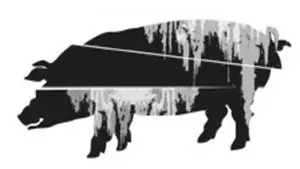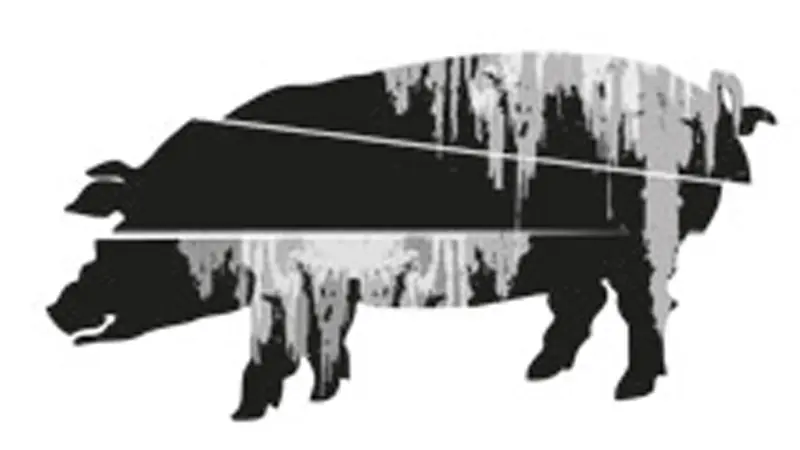 In Michigan, armed teams raid farms to enforce the slaughter of heritage breed pigs and piglets. Farmers who haven’t already killed their own animals become felons.
In Michigan, armed teams raid farms to enforce the slaughter of heritage breed pigs and piglets. Farmers who haven’t already killed their own animals become felons.- In Pennsylvania, after two years of harassment by the FDA, an Amish farmer gives up and shuts down his raw milk business.
- In Indiana (and elsewhere), a giant agricultural corporation forces its way onto the property of farmers, demands their records, sues them or threatens lawsuits because its patented crops accidentally cross-pollinated with theirs.
- In California, a multi-jurisdictional force, guns drawn, raids a raw foods co-op—twice.
- In Clark County, Nevada, where 51 ranchers once grazed herds on federal land, a lone man fights years of bureaucratic pressure and red tape to keep the lease that’s been in his family for more than 100 years.
- Also in Nevada, guests and shareholders of a community-supported organic farm were about to sit down to a farmto- fork dinner when a health inspector ordered the farmers to destroy every speck of the food—even though they had jumped through hoops to make sure they were doing everything right.
There is a war in this country. It’s being waged against … food. Specifically, it’s a war on family farms and ranches. It’s a war on foods that, for various reasons, don’t fit into the institutionalized, super-processed, chemical-laden, prepackaged, aggressively marketed, overpatented world of Monsanto, Cargill, Archer Daniels Midland, and their ilk.
There was a time I wouldn’t have written about a War on Food in the pages of S.W.A.T. Milk? Chickens? Farmers? They don’t (or shouldn’t) have anything to do with things SWAT-related. But with the return of this ‘zine’s classic emphasis on Survival Weapons and Tactics, it’s time to talk turkey. And soybeans. And organic, antibiotic-free, grass-fed beef.
After water, food is our most important survival tool. If we can’t exactly call those two things “weapons” … well, without them our customized .99-caliber Super Whizz-Whacker 3000s with special zombie-killing laser beams won’t get us very far.
Right now, Americans have dazzling options for getting and storing all manner of foods. But in a long-term emergency, we can expect store-bought foods to become scarce. Ultimately even those MREs and #10 cans of food we’ve stashed will run out (or we may open them to find they’ve gone bad). We will need local independent suppliers of simple, fresh, non-factory foods.
There’s also the issue of health. More and more of us are waking up to the fact that those “Monsantoized” foods we pluck from store shelves impair our survival by helping turn us into fat, diabetic, artery-clogged messes.
But even if we’re perfectly happy living on a diet of McStuff or confident we have enough bacon-flavored TVP to last into the 22nd century, this War on Food should concern us for another reason. It’s about control.
The excuse for any immediate move against a farm, ranch or co-op may be “food safety,” “overgrazing,” “wilderness protection,” “patent protection,” or something else altogether. But the targets are nearly always the little guys who don’t have the resources to fight back— and don’t have the pull to ensure that ag policy is customized for their interests.
Furthermore, the targets are the types of foods that lend themselves to local, small-scale production—veggies, eggs, milk, and meat. Not Yummy Industrial Corn-o-Things or Mmm-Good Super-Processed Wheat-o-Sugars. On the contrary, those—and delicious items like the pink slime used in commercial nuggets and burgers—are expressly government approved.
Take those raids on Michigan pig farms, for instance. The state’s Department of Natural Resources conducted the raids based entirely on bureaucratic diktat. The excuse: feral pigs can be dangerous and amazingly destructive. They are an invasive species.
It’s true about feral pigs. You wouldn’t want to meet up with one or have it rooting in your crops. They may also spread disease. Only thing is, none of the pigs involved were feral. On the contrary, all were captive on private property and some (the ones meant for trophy hunting) were inside containment systems fit for a POW camp. But any farmer caught keeping them is now subject to two years in prison and substantial fines.
The slaughtered animals were members of so-called heritage breeds—pigs that, had they escaped, possibly could have lived and bred in the wild. Never mind that they weren’t living and breeding in the wild. The edict that defined which pigs to slaughter classed these particularly “dangerous” breeds according to hair color, snout color, a tendency toward having striped babies, straight tails, and other seemingly arbitrary characteristics. Having a single such characteristic merits a death sentence.
Virtually every human affected was a small farmer or owner of a hunting ranch. The big industrial meat producers? The Michigan Pork Producers Association was all for it. They lobbied to make it happen, in fact. And those apparently arbitrary characteristics? Well, you see, those aren’t found in the “engineered” animals mass-produced for commercial purposes. The MPPA got government assurances that the slaughter wouldn’t affect them—only the other guys. The guys an increasingly health-conscious, survival-oriented nation might turn to.
No matter what the claim, this is the common denominator. It’s big government acting on behalf of (or at least with the support of ) big ag against people who serve a growing market of aware, discontented customers.
The reasons claimed are always plausible enough to lull those who aren’t watching closely. But sometimes there’s a large dose of irony (as well as tyranny and destruction of private property) in the outcome.
Take those two raids I mentioned on that California raw organic food co-op. The outfit was Rawsome Foods of Venice Beach. It was a members-only organization— therefore not technically a retail operation and therefore probably not requiring many of the licenses and inspections the state and the feds want. In other words, it was individuals making private decisions about what they chose to put into their and their families’ bodies—something free people do as a matter of course.
Rawsome was raided and three of its principals arrested on the grounds that raw milk can be a health hazard (again, that can be true, although some people think it has health benefits not found in pasteurized milk). To my knowledge, nobody ever demonstrated that Rawsome’s milk was a health hazard; only that it might be.
However, and here comes the irony, Rawsome actually was selling dangerous foods. One of the arrestees turned out to be a fraudster. Instead of raising free-range chickens, grass-fed lambs, etc on her ranch, she was making bulk purchases of commercially produced meats and eggs, repackaging them, and pulling in a tidy profit deluding co-op members. Her government-approved (but mislabeled) foods, with their burden of mercury, other heavy metals and toxic chemicals, were making chemically sensitive people ill.
Certainly co-op managers and members should have taken the initiative to check the real sources of the food they were buying. And they could sue the pants off the perpetrators. But armed raids by multiple government agencies? The only reason the word “overkill” doesn’t apply is that nobody’s been killed by these gun-toting bureaucrats—yet.
I called this a War on Food. But who’s the aggressor? Who exactly is so determined to bash the little guys into oblivion? Can I point to one single, vast conspiracy? No. Not even close. Do I believe that Evil Overlords from the Nevada Health Department are sitting down with villainous despots of the FDA or EPA to plot elimination of all privately grown foods? Are unindicted co-conspirators meeting secretly from Pennsylvania to Oregon to Washington, DC, to concoct one Nefarious Plot to end family farming? Not even.
But the fact that there is no one villain and no one stronghold to attack makes this War on Food all the more nefarious—and much harder to oppose. Where do you protest? Whom do you call? How do you stop hundreds of state agencies and dozens of federal ones acting in secret or in isolation? You can’t vote them out of office.
No, there is no Berlin bunker or Mordorian tower serving as headquarters in the War on Food. There’s just the bureaucratic desire to build fiefdoms, the belief that anything not supervised by government is inherently bad, and the fact that governments and big ag companies are thoroughly in each others’ pockets.
The federal government has been dedicated to controlling the nation’s agricultural production since before the 1930s case of Wickard v Fillburn, in which the Supreme Court declared that a farmer growing wheat for home consumption was engaging in interstate commerce and therefore subject to federal control.
And anybody who doesn’t understand that when you control the food supply, you control the population doesn’t know history.
Will the U.S. government—or any of the endless state bureaucracies involved in this war—ever “pull a Stalin” on small food producers? In the 1930s, when independent farmers in the Soviet Union’s southern breadbasket resisted collectivization, Stalin retaliated viciously. He confiscated their grain and livestock, closed off the region—and let millions starve. People ate their own children. In the end, the survivors submitted to Stalin’s will.
No, I don’t think such deliberate evil will—or even can—happen in the U.S. But after being herded for over 30 years toward a disastrous diet of industrialized high-grain, low-fat products— products of, by, and for big ag—there’s certainly a barrier being built. It’s a barrier designed to keep us from fleeing to local farmers and non-governmentapproved foods. A barrier designed to prevent the use of private property and private associations for private purposes. They say it’s all for our own good.
If they succeed and hard times come, it won’t be pretty. When grocery store shelves have emptied and just-in-time inventory has run out of time, it’ll be government and a few corporations that determine who’ll get food and what kind of food it’ll be.
For our own good? I don’t think so.



